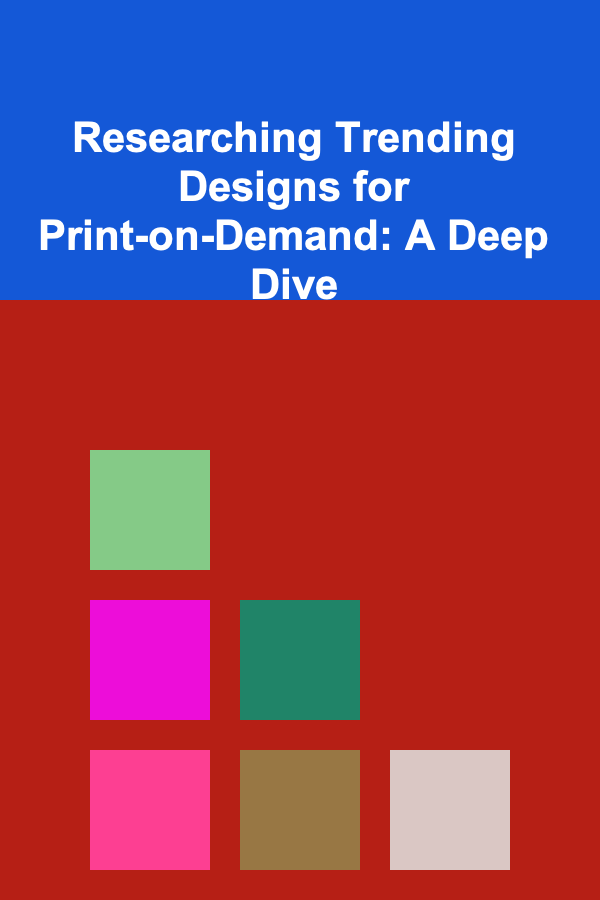
Researching Trending Designs for Print-on-Demand: A Deep Dive
ebook include PDF & Audio bundle (Micro Guide)
$12.99$6.99
Limited Time Offer! Order within the next:

The print-on-demand (POD) market has exploded in recent years, offering an accessible entry point for entrepreneurs and creatives alike. However, success in this competitive landscape hinges on identifying and capitalizing on trending designs. Simply creating aesthetically pleasing art is no longer enough; you need to understand what customers are actively searching for and willing to buy. This article provides a comprehensive guide to researching trending designs for print-on-demand, covering a range of strategies, tools, and analytical techniques to help you stay ahead of the curve and maximize your profitability.
I. Understanding the Print-on-Demand Ecosystem
Before diving into research methods, it's crucial to understand the nuances of the POD ecosystem. This involves recognizing the key players, platforms, and influencing factors that shape design trends.
A. Key Players: Customers, Designers, Platforms, and Manufacturers
- Customers: The end-users of your products. Their preferences, demographics, and purchasing habits drive trends. Understanding their needs and desires is paramount.
- Designers: You and other creators vying for customer attention. Analyzing successful designers' strategies can provide valuable insights.
- Platforms: Marketplaces like Etsy, Amazon Merch on Demand, Redbubble, Teespring, and Society6 act as intermediaries. Each platform has its own audience and trending product categories.
- Manufacturers: The companies that print and ship the products. While you might not directly interact with them, understanding their product offerings and limitations is important.
B. Platforms and Their Niches
Each POD platform attracts a specific audience and often specializes in certain product categories. Here's a brief overview:
- Etsy: Known for handmade, vintage, and craft supplies. Trending designs often involve personalized gifts, wedding-related items, and unique art prints.
- Amazon Merch on Demand: A massive marketplace with a broad customer base. Focuses on t-shirts, hoodies, and phone cases. Keyword optimization is critical here.
- Redbubble: Caters to a younger, art-focused demographic. Stickers, phone cases, and apparel featuring quirky designs and fan art are popular.
- Teespring (Spring): Primarily focuses on apparel, but also offers other products like mugs and tote bags. Often used for crowdfunding campaigns and limited-edition designs.
- Society6: Specializes in art prints, home decor, and apparel featuring artwork from independent artists. A great platform for showcasing your artistic style.
C. Factors Influencing Design Trends
Many factors contribute to the emergence and evolution of design trends in the POD world. Being aware of these factors will help you anticipate upcoming trends and create designs that resonate with your target audience.
- Seasonal Events: Holidays (Christmas, Halloween, Valentine's Day), special occasions (birthdays, anniversaries), and seasonal changes (spring, summer, autumn, winter) significantly impact demand.
- Cultural Events: Major sporting events (Olympics, World Cup), movie releases, music festivals, and social movements can trigger specific design trends.
- Current Events: News headlines, social issues, and political events often inspire designs that reflect popular sentiment. However, be cautious when addressing sensitive topics.
- Pop Culture: Memes, viral videos, popular TV shows, and emerging artists can quickly become design inspiration.
- Social Media Trends: Platforms like TikTok, Instagram, and Pinterest are breeding grounds for new trends. Pay close attention to hashtags, challenges, and viral content.
- Color Trends: Pantone's Color of the Year and other color forecasting initiatives can influence design preferences.
- Fashion Trends: Clothing styles and accessories often inspire designs for apparel and other POD products.
II. Research Methodologies: Unveiling Hidden Trends
Effective trend research requires a multi-faceted approach, combining both quantitative and qualitative data. Here are several proven methodologies you can employ:
A. Keyword Research: Understanding Search Intent
Keyword research is fundamental to understanding what customers are actively searching for. By identifying relevant keywords with high search volume and low competition, you can optimize your product listings and improve your visibility.
- Brainstorming: Start by brainstorming a list of potential keywords related to your niche. Think about what your target audience might search for when looking for products like yours.
- Keyword Research Tools: Utilize tools like Google Keyword Planner, SEMrush, Ahrefs, and Moz Keyword Explorer to analyze keyword volume, competition, and related keywords. While some of these tools require a paid subscription, many offer free trials or limited access for basic research.
- Long-Tail Keywords: Focus on long-tail keywords (phrases with three or more words) as they are typically less competitive and more specific, attracting a more targeted audience. For example, instead of "t-shirt," try "funny cat t-shirt for men."
- Google Trends: Use Google Trends to track the popularity of keywords over time, identify seasonal trends, and compare the relative popularity of different search terms. This is a free and powerful tool for understanding search interest.
- Platform-Specific Keyword Research: Some platforms, like Etsy, have their own keyword research tools or search suggestion features. Utilize these tools to understand how users are searching within that specific marketplace.
- Competitor Analysis: Analyze the keywords used by your competitors in their product listings and descriptions. This can provide valuable insights into successful search terms.
B. Platform Analysis: Diving Deep into Marketplaces
Analyzing the leading POD platforms is essential for identifying trending products and design styles. Each platform has its own unique audience and algorithms, so tailoring your research to the specific platform is critical.
- Bestseller Analysis: Browse the bestseller sections of each platform to identify the top-selling products in your niche. Pay attention to the design elements, product types, and pricing strategies used by successful sellers.
- Trending Product Pages: Many platforms have dedicated pages showcasing trending products and designs. These pages offer a snapshot of what's currently popular.
- Search Functionality: Utilize the platform's search function to explore different keywords and see what types of products are being displayed. Pay attention to the search results and the recommended keywords.
- Customer Reviews: Read customer reviews to understand what customers are looking for in a product and what they appreciate about successful designs. This can reveal unmet needs and opportunities for improvement.
- Competitor Shop Analysis: Analyze the product listings, shop descriptions, and social media presence of successful sellers on each platform. Look for patterns and common themes in their designs and marketing strategies.
- Price Point Analysis: Observe the price ranges of similar products to understand the competitive landscape and determine appropriate pricing for your designs.
C. Social Media Monitoring: Capturing the Pulse of the Internet
Social media platforms are invaluable sources of information about trending designs. They provide real-time insights into what people are talking about, sharing, and liking.
- Hashtag Research: Track relevant hashtags related to your niche, design styles, and product categories. Analyze the content being shared under these hashtags to identify emerging trends.
- Trend Identification Tools: Utilize social media trend identification tools like BuzzSumo, Sprout Social, and Hootsuite to monitor trending topics, keywords, and influencers.
- Influencer Marketing: Follow relevant influencers and analyze their content to identify design trends and product preferences. Consider collaborating with influencers to promote your designs.
- Platform-Specific Trends: Pay attention to trends specific to each social media platform. For example, TikTok is known for its viral challenges and short-form video content, while Instagram is more visually focused.
- Social Listening: Monitor social media conversations related to your niche to understand customer sentiment, identify pain points, and discover new opportunities.
- Visual Search: Utilize visual search tools like Google Lens and Pinterest Lens to identify similar designs and products based on images.
D. Niche-Specific Research: Focusing Your Efforts
Identifying a specific niche within the POD market can help you target your research efforts and create designs that resonate with a particular audience. This allows you to become an expert in a specific area and build a loyal customer base.
- Identify Your Passion: Choose a niche that you are genuinely interested in. This will make the research process more enjoyable and help you create authentic designs.
- Analyze Niche Market Size: Research the market size and potential demand for your chosen niche. Ensure that there is a sufficient audience to support your business.
- Competitor Analysis within the Niche: Analyze the existing competition within your niche. Identify successful sellers and analyze their designs and marketing strategies.
- Niche-Specific Forums and Communities: Participate in online forums and communities related to your niche to understand customer needs, identify trending topics, and gather feedback on your designs.
- Niche-Specific Blogs and Publications: Follow blogs and publications that cater to your chosen niche. These sources often provide insights into emerging trends and design preferences.
- Customer Surveys: Conduct customer surveys to gather feedback on your designs and understand their preferences within your niche.
E. Visual Trend Analysis: Deciphering Design Aesthetics
Understanding visual design trends is crucial for creating aesthetically appealing and marketable products. This involves analyzing color palettes, typography, imagery, and overall design styles.
- Color Palette Analysis: Research trending color palettes using tools like Adobe Color, Coolors, and Paletton. Pay attention to the colors being used in popular designs and advertising campaigns.
- Typography Analysis: Analyze trending fonts and typography styles. Experiment with different font pairings and layouts to create visually appealing designs. Google Fonts is a valuable resource for free and open-source fonts.
- Imagery Analysis: Research trending imagery styles, such as minimalist illustrations, abstract art, and photographic styles. Consider using high-quality stock photos or creating your own original artwork.
- Design Style Analysis: Identify trending design styles, such as retro, vintage, minimalist, and geometric. Experiment with different styles to find what resonates with your target audience.
- Mood Board Creation: Create mood boards to visually represent your design concepts and explore different design directions.
- Design Inspiration Websites: Browse design inspiration websites like Dribbble, Behance, and Awwwards to discover new design trends and techniques.
III. Tools and Resources for Trend Research
The digital landscape offers a plethora of tools and resources to streamline your trend research process. Here's a curated list:
A. Keyword Research Tools:
- Google Keyword Planner: Free tool from Google for keyword research.
- SEMrush: Comprehensive SEO and keyword research tool (paid subscription).
- Ahrefs: Powerful SEO tool with robust keyword research capabilities (paid subscription).
- Moz Keyword Explorer: SEO tool with keyword research and rank tracking features (paid subscription).
- Ubersuggest: Free and paid keyword research tool from Neil Patel.
- KeywordTool.io: Keyword research tool that generates keyword ideas from various sources.
B. Trend Identification Tools:
- Google Trends: Free tool from Google for tracking the popularity of search terms over time.
- BuzzSumo: Content marketing tool for identifying trending topics and influencers (paid subscription).
- Sprout Social: Social media management tool with trend monitoring features (paid subscription).
- Hootsuite: Social media management tool with trend monitoring and analytics (paid subscription).
- Exploding Topics: Identifies rapidly growing trends before they become mainstream (paid subscription).
C. Social Media Monitoring Tools:
- Mention: Social media monitoring tool for tracking brand mentions and conversations (paid subscription).
- Brand24: Social media monitoring tool for tracking brand mentions and sentiment analysis (paid subscription).
- Awario: Social media monitoring tool with real-time alerts and analytics (paid subscription).
D. Visual Design Resources:
- Adobe Color: Tool for creating and exploring color palettes.
- Coolors: Color palette generator.
- Paletton: Color scheme designer.
- Google Fonts: Library of free and open-source fonts.
- Dribbble: Website for showcasing design work and discovering new trends.
- Behance: Online platform for showcasing and discovering creative work.
- Awwwards: Website showcasing the best web design examples.
- Unsplash: Website offering free high-resolution photos.
- Pexels: Website offering free stock photos and videos.
E. Platform-Specific Tools and Resources:
- Etsy Rank: Etsy SEO tool for keyword research and competitor analysis (paid subscription).
- Merch Informer: Tool for Amazon Merch on Demand keyword research and product analysis (paid subscription).
- Redbubble Trends: Unofficial tool for analyzing trending searches on Redbubble. (often requires manual verification)
IV. Analyzing and Interpreting Data: Turning Insights into Action
Gathering data is only the first step. The real challenge lies in analyzing and interpreting that data to identify actionable insights that can inform your design strategy.
A. Identifying Patterns and Themes
Look for recurring patterns and themes in your research data. Are certain keywords consistently popular across different platforms? Are there specific design styles that are trending across social media? Identifying these patterns will help you focus your efforts on the most promising opportunities.
B. Evaluating Market Demand and Competition
Assess the market demand for different design trends by analyzing search volume, social media engagement, and sales data. Compare this with the level of competition in each area. Focus on trends with high demand and relatively low competition.
C. Predicting Future Trends
Use your research data to predict future trends. Consider the factors influencing design trends (seasonal events, cultural events, current events, pop culture, social media trends, color trends, fashion trends) and anticipate how these factors might shape design preferences in the coming months.
D. Validating Your Ideas
Before investing significant time and resources into creating designs based on your research, validate your ideas. Share your design concepts with your target audience and gather feedback. Consider running A/B tests to compare the performance of different designs.
E. Iterative Design Process
Embrace an iterative design process. Continuously monitor the performance of your designs and make adjustments based on customer feedback and market trends. Don't be afraid to experiment with new ideas and refine your approach.
V. Ethical Considerations in Trend Research
It is crucial to conduct trend research ethically and avoid infringing on the intellectual property rights of others.
A. Avoiding Copyright Infringement
Ensure that your designs do not infringe on existing copyrights. Avoid using copyrighted characters, logos, or artwork without permission. Use original artwork or license stock photos and graphics.
B. Respecting Trademark Rights
Avoid using trademarks in a way that could cause confusion or deception. Research trademarked words and phrases before incorporating them into your designs. Consult with a legal professional if you are unsure about the legality of your design.
C. Being Authentic and Original
Strive to create authentic and original designs. Avoid simply copying the designs of others. Draw inspiration from multiple sources and develop your own unique style. Customers appreciate originality and are more likely to support designers who create unique and compelling artwork.
D. Transparency and Attribution
If you use inspiration from other sources, be transparent about it. Attribute the original creators where appropriate. Give credit where credit is due.
VI. Conclusion: The Ongoing Pursuit of Trends
Researching trending designs for print-on-demand is an ongoing process. The market is constantly evolving, and new trends emerge regularly. By implementing the strategies and tools outlined in this article, you can stay ahead of the curve, create designs that resonate with your target audience, and achieve success in the competitive POD landscape. Remember to combine quantitative and qualitative research, analyze data effectively, and prioritize ethical design practices. Embrace continuous learning and adaptation, and you'll be well-positioned to capitalize on the ever-changing world of print-on-demand.

How to Add Luxury Features to Your Home Renovation
Read More
How to Create a Checklist for Community Engagement in Event Promotion
Read More
How to Organize Your Pantry for Easy Access and Space Efficiency
Read More
How To Master Drone Videography
Read More
How To Encourage Positive Behavior with Gentle Discipline
Read More
Mastering Pacing and Suspense in Your Writing
Read MoreOther Products

How to Add Luxury Features to Your Home Renovation
Read More
How to Create a Checklist for Community Engagement in Event Promotion
Read More
How to Organize Your Pantry for Easy Access and Space Efficiency
Read More
How To Master Drone Videography
Read More
How To Encourage Positive Behavior with Gentle Discipline
Read More